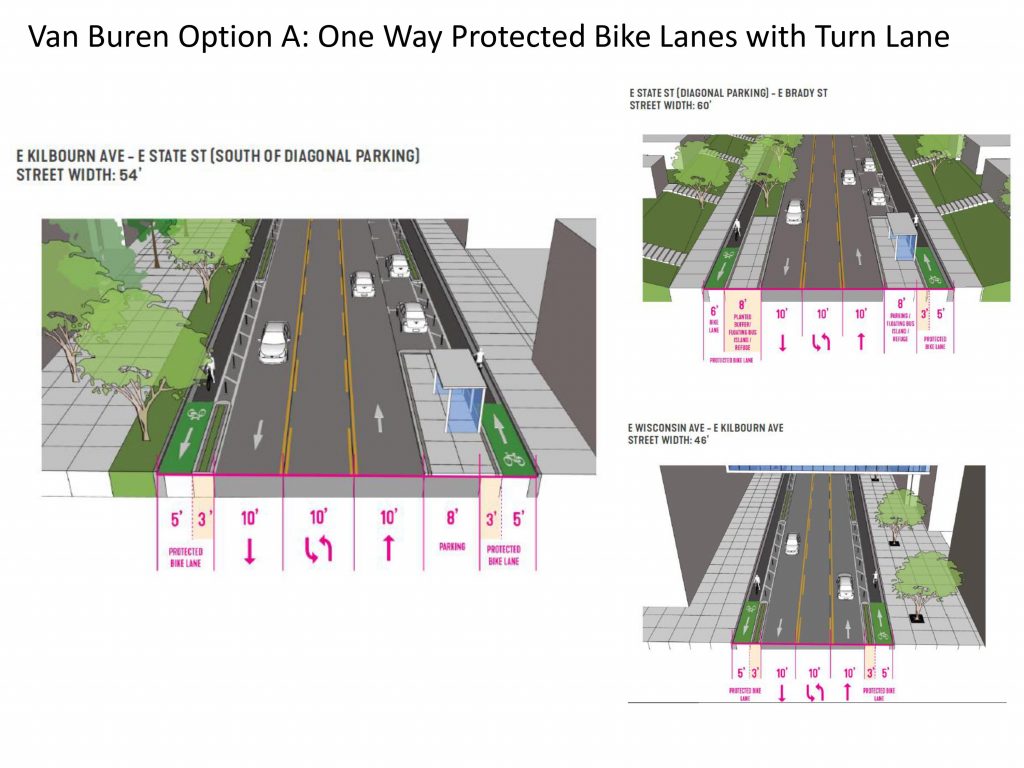Study Shows Narrow Travel Lanes are Safer
All the city news you can use.

One of the proposed designs for the planned Van Buren Street reconfiguration would narrow travel lanes to 10 feet. Image from the City of Milwaukee.
Every day at The Overhead Wire we sort through over 1,500 news items about cities and share the best ones with our email list. At the end of the week, we take some of the most popular stories and share them with Urban Milwaukee readers. They are national (or international) links, sometimes entertaining and sometimes absurd, but hopefully useful.
Narrow travel lanes are safer: A group of researchers led by Dr. Shima Hamidi at the Johns Hopkins School of Public Health looked at 1,000 urban street sections and found that narrow travel lanes are safer at the 30-35mph speed limit, and provide more space for active transportation and landscaping. They suggest that low speed streets would be immediate candidates for lane width reductions which can be done during routine repaving. They also believe urban areas should have a default lane width of 10 feet. (Robert Steutevill | CNU Public Square)
Navigating transit’s financial woes: Transit agencies have been facing tough headwinds after the toughest part of the pandemic with many on a path to hit fiscal uncertainty in the next few years. Two recent webinars and several reports hint at some of the ways transit agencies can improve their fortunes including the diversification of funding sources and pushing for more flex funds from state highway departments which is allowed by federal transportation laws. (Jared Brey | Governing)
Baby boomers prevailing in housing purchases: The housing market is still hot, buoyed by short supply and older buyers with the ability to avoid the high interest rates through cash offers. New data released by the National Association of realtors found that the median age for a home buyer was 58. In 1981, the median age was 36. The market is still rough for first time buyers, especially young ones looking for an affordable home. (Rachel Siegel | Washington Post)
Is the land value tax idea back?: Detroit’s mayor is one of the few in the country considering a Georgist land value tax in order to raise rates on vacant land and lower it on parcels with occupied structures. Interestingly enough he hadn’t heard of Georgism. But the hope with implementation is that a more equitable system emerges where speculation is reduced and redevelopment is rewarded. The only stumbling block now is getting the state of Michigan to let them do it. (Conor Dougherty | New York Times)
Quote of the Week
I’ve spoken with staffers in a dozen federal agencies this year while rolling out my book about government culture and effectiveness. I heard over and over about rigid, maximalist interpretations of rules, regulations, policies and procedures that take precedence over mission. Too often acting responsibly in government has come to mean not acting at all.
–Jennifer Pahlka in the Washington Post discussing how the gears of government have ground to a halt in the ‘Kludgeocracy’.
This week on the podcast, we’re joined by transit expert and former general manager for three transit systems Ron Kilcoyne, who talks about the importance of running frequent transit service to attract riders.
Want more links to read? Visit The Overhead Wire and signup.
If you think stories like this are important, become a member of Urban Milwaukee and help support real, independent journalism. Plus you get some cool added benefits.
Transportation
-
Congestion Pricing Cuts Air Pollution in New York City
 Dec 14th, 2025 by Jeff Wood
Dec 14th, 2025 by Jeff Wood
-
FTA Tells Milwaukee to Crack Down on Fare Evasion — Even Where Fares Don’t Exist
 Dec 12th, 2025 by Graham Kilmer
Dec 12th, 2025 by Graham Kilmer
-
Will GOGO’s Bus Service Ever Get Going?
 Dec 9th, 2025 by Jeramey Jannene
Dec 9th, 2025 by Jeramey Jannene
Urban Reads
-
Congestion Pricing Cuts Air Pollution in New York City
 Dec 14th, 2025 by Jeff Wood
Dec 14th, 2025 by Jeff Wood
-
We Think We Love to Drive. But Do We Really?
 Dec 7th, 2025 by Jeff Wood
Dec 7th, 2025 by Jeff Wood
-
Can Scott Wiener Tackle America’s Housing Crisis?
 Nov 23rd, 2025 by Jeff Wood
Nov 23rd, 2025 by Jeff Wood






















Looked at the narrower lane article. Very opened ended study. It assumes drivers are more cautious amd considerate. Not my experience in Milwaukee.